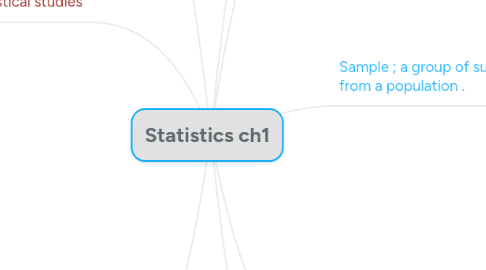
1. Type of statistics
1.1. 1- Descriptive statistics
1.1.1. Consists of the collection , organization , summarization, and presentation of data .
1.1.1.1. Average median standard deviation mode
1.1.2. وصفي : حساب مقياس وطلع نتيجة / نسبة الشي / جدول للدالة او رسم
1.2. 2- inferential statistics
1.2.1. Consists of generalizing from samples to populations , performing estimates and hypotheses tests , determining relationships among variable and making predictions .
1.2.1.1. Use probability : the chance of an event occurring.
1.2.1.2. The area of it called hypothesis testing : a decision making process for evaluating claims about a population, based on inform. Obtained from samples.
1.2.2. استدلالي : عبارة مستقبلية / علاقة بين شيئين / شركة تتوقع في ٢٠١٨ نسبة الارباح تكون ٥٠ ٪ ، رغم انه في نسبة لكن العبارة كلها عن المستقبل اذاً استدلالي
2. Type of statistical studies
2.1. Observational study
2.1.1. The recession merely observe what is happening or what has happened in the past and tries to draw conclusion based on these observation
2.2. Experimental study
2.2.1. The researchers manipulate one of the variables and tries to determine how the manipulation influence other variables
2.2.1.1. Advantage :
2.2.1.1.1. Researchers can decide how to select subjects and how to assign them to specific group also can control or manipulate the independent variable
2.2.1.2. Disadvantages
2.2.1.2.1. They may occur in un-natural setting, such as laboratories and special classrooms
2.2.1.2.2. Hawthorne effect
2.2.1.3. Confounding variables : influence the dependent or outcome variables but wasn't separated from the independent variables
3. Uses and misuses of statistics
3.1. Suspect sample
3.1.1. Very small sample
3.1.2. Convenience sample
3.1.3. Volunteer sample
3.1.4. عينة صغيرة ، رأي عشر اشخاص
3.2. Ambiguous average
3.2.1. Mean median mode midrange
3.3. Changing the subject
3.3.1. اختيار الكلمات والتلاعب بها مثل خسارة ٣٠٪ او خسارة ثلاثين مليون للعبارتان نفس المعنى ولكن نتيجتهما رأيان مختلفان
3.4. Detached statistics
3.4.1. There is no comparison is made , compared to what ?
3.4.2. مثلا هذه الشركة اكثر امانة .. المفروض يقارنوها ب شركة اخرى / لايوجد مقارن به
3.5. Implied connections
3.5.1. May , might , suggest , some
3.5.2. عبارات عدم التأكد ١٠٠ ٪
3.6. Misleading graph
3.6.1. Statistical graph give a visual representation of data that enables viewers to analyze and interpret data more easily than by simply looking at nu.
3.7. Faulty survey questions
3.7.1. لو مدرسة طلبت موافقة الاباء في بناء ملعب ووقعوا على الموافقة ومن ثم المدرسة رفعت رسومها لبنائه هنا سيحدث اعتراض من الاباء لأن السؤال لم يُذكر فيه رفع الرسوم/ طريقة السؤال تغير رأي الشخص / اسئلة مبهمة .
4. Is the science of conducting studies to :
4.1. Organize
4.2. Summarize
4.3. Analyze
4.4. Draw conclusion from data
4.5. Collect
5. Data : the values that the variables can assume.
5.1. Data set : A collection of data values
5.2. Data value \ datum : each value in the data set.
6. Sample ; a group of subjects selected from a population .
6.1. The four basic methods of sampling are
6.1.1. 1- random sampling
6.1.1.1. Is a sample in which all members of the population has an equal chance of being selected.
6.1.2. 2- systematic sampling
6.1.2.1. Is a sample obtained by selecting a every kth member of the population where K is a counting number
6.1.2.2. تُعرف من كلمة every , k= any number
6.1.3. 3- Stratified sampling
6.1.3.1. Subject are selected by dividing up the population into subgroups and subjects are randomly selected within subgroups
6.1.4. 4-Cluster sampling
6.1.4.1. subject are selected by using an intact subgroup that is representative of the population
6.2. Error
6.2.1. Sampling error
6.2.1.1. The difference between the results obtained from a sample and the results obtained from the population from which the sample was selected
6.2.2. Nonsampling error
6.2.2.1. Occurs when the data are obtained erroneously or the sample is biased nonpresentative
6.3. درست اطوال ٥٠٠ شخص
7. Population; consists of all subjects that are being studied.
7.1. طلاب الجامعة / متوسط العدد
8. Variables : a characteristic or attribute that can asuume different vaules.
8.1. 1- qualitative: variables that have distinct categories according to some characteristics or attribute.
8.1.1. وصفي
8.2. 2- quantitative variables
8.2.1. Are variables that can be counted or measured
8.2.1.1. 1- discrete variables : assume values that can be counted .
8.2.1.1.1. منفصل : تحمل قيم يمكن عدها
8.2.1.2. 2- continuous variables: can assume an inf number of values between any two specific values .
8.2.1.2.1. They are obtained by measuring. They often include fractions and decimals.
8.2.1.2.2. متصل : عادة ماتحتوي كسور و كسور عشرية
8.2.2. كمي او عددي
8.3. Level Measurement of the data :
8.3.1. Nominal level
8.3.1.1. Classifies data into categories that can be ranked however, precise differences between the ranks do not exist
8.3.2. Ordinal level
8.3.2.1. It classifies data into mutually exclusive Categories in which no order or ranking can be imposed on the data .
8.3.3. Interval level
8.3.3.1. ranks data and Precise difference between units of measure do exist however, there is no meaningful zero.
8.3.4. Ratio level
8.3.4.1. Possesses characteristics of interval measurement and there exists a true zero in a addition to true ratios exist when the same variables is measured on two different members of the population
